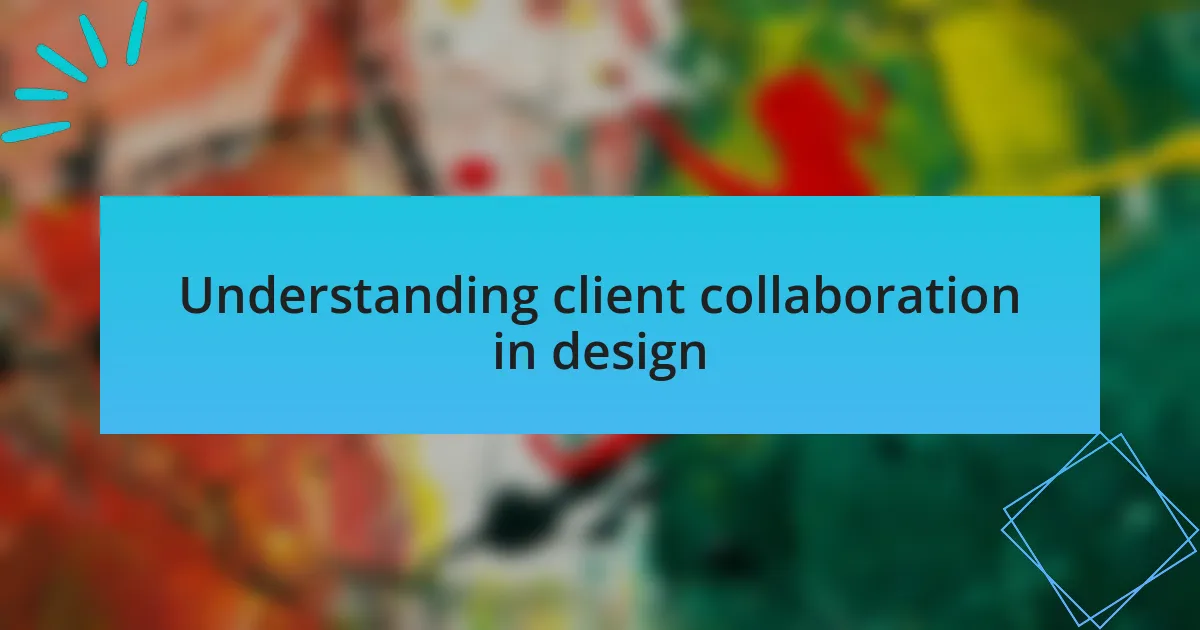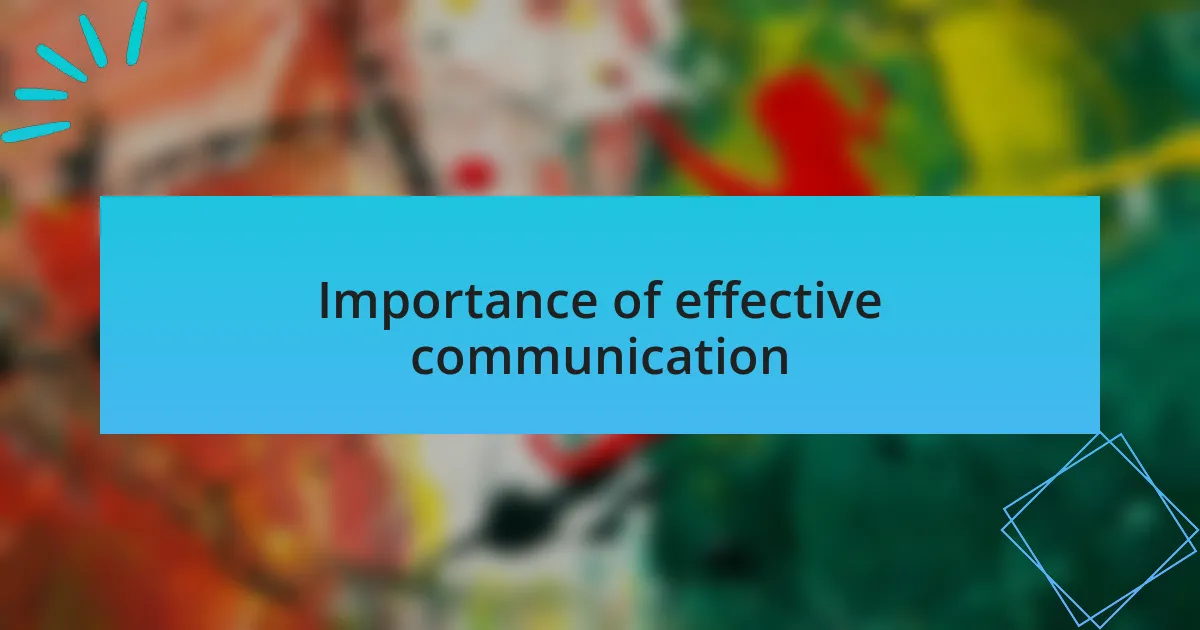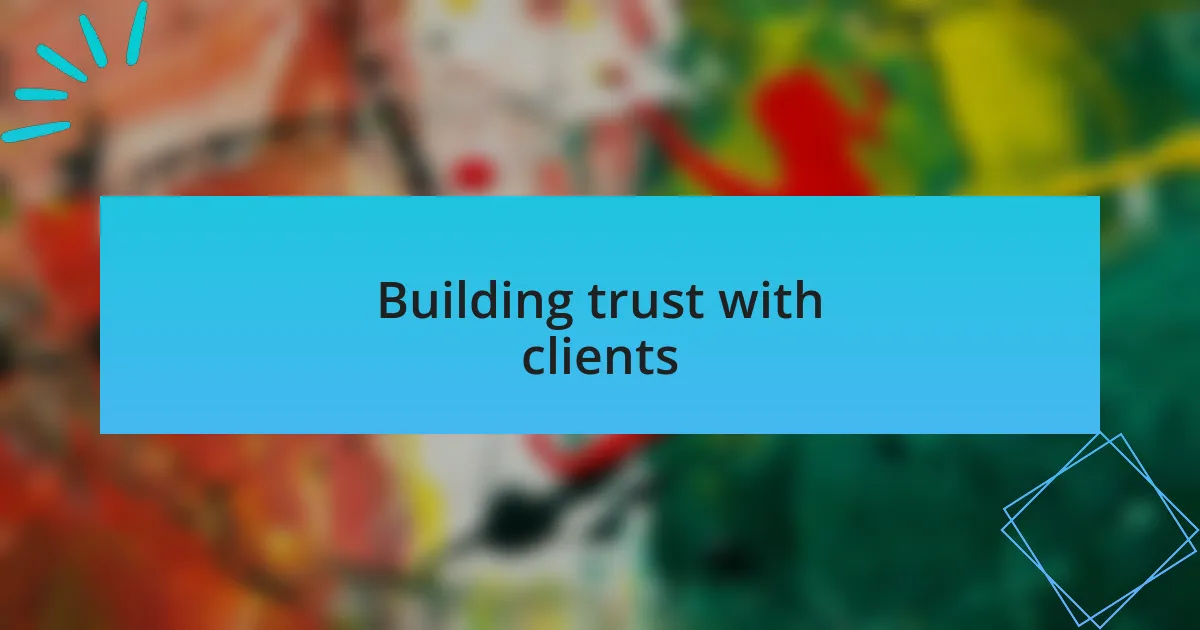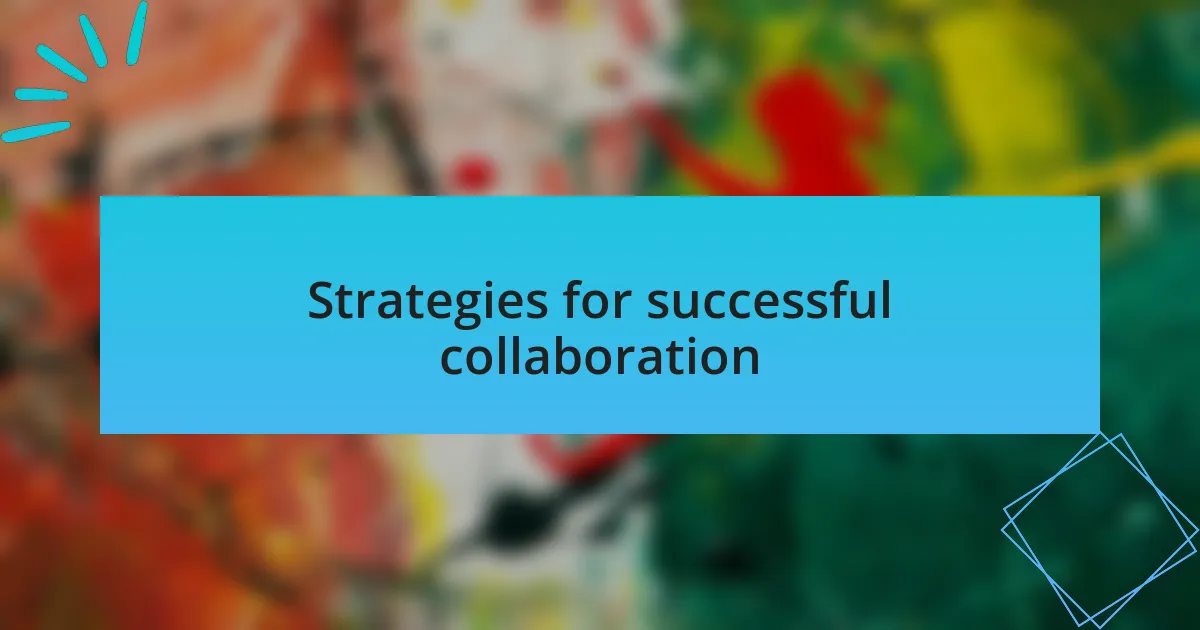Key takeaways:
- Effective communication and active listening are vital for transforming a client’s vision and ensuring successful collaboration.
- Building trust requires transparency and managing expectations, along with regular follow-ups to celebrate progress.
- Embracing client feedback can lead to innovative design solutions and deeper emotional connections with the project.
- Personal growth in design often comes from stepping out of comfort zones and learning through challenging client interactions.

Understanding client collaboration in design
Collaboration with clients in design isn’t just about exchanging ideas; it’s about building a relationship. I remember a project where the client was initially hesitant, unsure of their vision. Through open communication, I learned that asking the right questions helped them articulate their thoughts—turning apprehension into excitement for what was to come.
Listening plays a crucial role in this process. I often find that clients have unique perspectives that can reshape my understanding of design. One time, a client shared a personal story related to their brand, which transformed my design approach entirely. I realized then that design isn’t just about aesthetics; it’s about conveying a message that resonates deeply with the audience.
Every collaboration brings its own challenges and rewards. I’ve faced moments where differing opinions clashed, leading to tension. However, I’ve discovered that navigating those disagreements often results in the best solutions. Isn’t it interesting how collaboration can push us beyond our limits and lead to outcomes we never envisioned? Through these experiences, I’ve come to appreciate that the design process is as much about partnership as it is about creativity.

Importance of effective communication
Effective communication acts as the backbone of any successful client collaboration. I’ve experienced firsthand how a simple conversation can shift the entire trajectory of a project. Once, I had a client who felt their vision wasn’t being understood. After initiating a dialogue, they opened up about their brand’s values and aspirations, allowing me to align my design accordingly. Isn’t it empowering to see how clarity can pave the way for creativity?
Moreover, I’ve found that communication isn’t just about verbal exchanges; it also encompasses body language and visual cues. During one project, I noticed a client’s shifting expressions during our discussions as I presented concepts. This prompted me to pause and ask for their thoughts. It was a small moment that led to uncovering hesitations I hadn’t anticipated, which ultimately refined my designs. How often do we overlook non-verbal signals that could enrich our understanding?
Lastly, establishing a feedback loop is vital. I remember a time when I created several design iterations based on early conversations, only to realize later that the intended message wasn’t coming through. By soliciting ongoing feedback, the client felt more involved, resulting in a final product that truly represented their vision. It’s fascinating how this exchange can transform a design process into a collaborative journey, where both parties feel invested and understood.

Building trust with clients
Building trust with clients is essential in fostering a collaborative environment. I recall a project where I faced initial skepticism from a client about my design choices. By openly sharing my creative process and inviting them to contribute ideas, I gradually transformed that doubt into confidence. Have you ever witnessed a shift in a client’s demeanor when they feel included? It’s a remarkable experience that builds rapport.
Trust also flourishes when expectations are managed effectively. There was a time when I underestimated the timeline for a project, leading to frustration on both sides. By acknowledging the misstep and transparently discussing how we could regroup, I was able to rebuild their faith in my work. This taught me that honesty, even about setbacks, can strengthen relationships.
Additionally, consistently following up is a game-changer. I make it a point to check in regularly, not just to gauge progress but to celebrate milestones together. During one collaboration, I sent a quick note to acknowledge a small win, and the client responded with enthusiasm. It was a simple gesture, but it reinforced our connection and showed them I genuinely cared about their journey. Aren’t those moments the ones that solidify lasting partnerships?

Strategies for successful collaboration
Collaboration thrives on open communication. I remember a project where we hit a snag during the design phase. Instead of waiting for discussions to happen informally, I organized a dedicated meeting to address the issues at hand. The result? Not only did we come up with innovative solutions together, but our collective brainstorming left everyone feeling more invested in the project. Isn’t it interesting how a simple meeting can turn challenges into opportunities?
Adapting to client feedback is another crucial strategy. Early in my career, I underestimated the power of flexibility. A client suggested a direction I initially disagreed with, but by giving it a fair chance and incorporating their ideas, I discovered new design possibilities that exceeded our expectations. This experience taught me to embrace feedback as a powerful tool, even when it feels uncomfortable. Have you ever found gold in a suggestion that you originally dismissed?
Finally, setting clear roles and responsibilities helps prevent misunderstandings. I once worked on a campaign where everyone assumed someone else would handle client communication, leading to confusion and frustration. Once we clarified who was responsible for what, the workflow became smoother, and it enhanced our collective accountability. It’s fascinating how clarity can transform chaos into harmony, wouldn’t you agree?

Learning from client feedback
In my experience, client feedback often reveals insights that can reshape a project entirely. I once received an unexpected comment from a client about a color scheme that initially felt out of place to me. After taking a step back and revisiting their perspective, I realized that their cultural background deeply informed their preferences, leading to a subtle yet impactful design adjustment that resonated more authentically with their audience. Have you ever found yourself surprised by the rationale behind a client’s choice?
Listening to client feedback is not just about hearing their words; it’s about understanding their vision and emotional connection to the project. I recall a time when a client expressed frustration with how the design was reflecting their brand. Instead of brushing it off, I made it a priority to truly understand their brand story. This deep dive into their narrative not only reassured them but also inspired me to elevate the design, creating something that not only met their expectations but also evoked their passion for the brand. Isn’t it intriguing how tapping into emotions can yield design results that are truly aligned with client aspirations?
There have been moments when I didn’t fully embrace client feedback, thinking I knew best. I remember one project where I resisted making a change that I believed would dilute the design’s integrity. Eventually, I learned that incorporating their feedback not only strengthened our collaboration but also led me to create something I had never envisioned. Reflecting on that experience, it became clear to me that client feedback isn’t just critique; it’s a pathway to innovation. Have you ever doubted a suggestion, only to find it leading you to a creative breakthrough?

Personal growth through client interactions
Engaging with clients has profoundly shaped my approach to design, pushing me out of my comfort zone. I recall working with a small business owner who had an unconventional vision for their website. Initially, I hesitated to fully embrace their ideas, thinking they were too far removed from industry standards. However, as we collaborated, I learned that honoring their unique perspective inspired a more innovative design solution that ultimately stood out in the marketplace. Have you ever realized that stepping back and welcoming unconventional ideas can unlock creative potentials you never considered?
My interactions with clients have also taken me on an emotional journey. One project involved partnering with a non-profit organization that aimed to raise awareness about mental health. Listening to their stories and understanding their mission was not only empowering but also taught me the importance of empathy in design. Instead of just creating a visually appealing layout, I found myself absorbed in crafting a user experience that fostered connection and understanding. Reflecting on this, I realized that personal growth in my work often comes from these emotional investments. Isn’t it fascinating how design can carry such deep significance when we genuinely connect with our clients?
Each client encounter has provided me with invaluable lessons about the industry and myself. I remember a particularly challenging project where the client had very specific needs that didn’t align with my usual design approach. Throughout the process, I felt frustrated at times, yet I pushed to adapt and learn. By the end, I not only delivered the project but also discovered new techniques that have since enriched my design practice. Isn’t it intriguing how discomfort can lead to growth?